The theatrical year began 12 April 1790 and ended 16 April 1791.
| Directors : the Actors | |
| Actors | Actresses |
|---|---|
| Molé | Bellecour |
| Larive | Vestris |
| Dugazon | Giguet |
| Desessarts | Lachassaigne |
| Dazincourt | Suin |
| Fleury | Saint-Val |
| Belmont | Raucourt |
| Vanhove | Contat |
| Dorival | Thénard |
| Saint-Prix | Joly |
| Saint-Fal | De Vienne |
| Naudet | Émilie Contat |
| Dunant | Petit |
| Grammont | Lauréat |
| Larochelle | Candeille |
| Talma | Desgarcins |
| Roga | Fleury |
| Marsy | Masson |
| Marchand | Charlotte |
| Champville | Lange |
| Deshayes | Simon |
| Gérard | |
| Grand-Ménil | |
| Dancers | Female dancers |
| Deshayes, ballet master | Mlle Collomb, first dancer |
| Nores, first dancer | Aimée, danseuse en double |
| Doucet, danseur en double | Bourgeois, danseuse en double |
| Marchand | Dantié |
| Gignet | Bourgeois the young |
| Cosson | Durand |
| Évrard | Duchaumont the elder |
| Audill | Védi |
| Mulot | Duchaumont the young |
| Rogat | Vaudrelant |
| Huot | Félicité |
| Chaudet, répétiteur | |
| Orchestra | |
| Baudron, 1st violin and composer | La Lance, 1st violin |
| Chaudet, 1st violin | Fillion, 1st violin |
| Rose, 1st violin | Marteau, 1st violin |
| Cunissy, 2nd violin | Fleury, 2nd violin |
| Rameau, 2nd violin | Milot, 2nd violin |
| Bertrand, 2nd violin | Hugot, 2nd violin |
| Rougeaux, alto | Prot, alto |
| André, oboe | Le Det, timpanist |
| Deshais, oboe | Ducreux, oboe |
| Pilet, oboe | Tuasch, bassoon |
| Dumonet, cor | Heins, cor |
| Jolet, bass | Chapelet, bass |
| Toutant, bass | Prunelle, bass |
| Gresset, double bass | Raoul, copyist |

The Panthéon is a monument in the 5th arrondissement of Paris, France. It stands in the Latin Quarter, atop the Montagne Sainte-Geneviève, in the centre of the Place du Panthéon, which was named after it. The edifice was built between 1758 and 1790, from designs by Jacques-Germain Soufflot, at the behest of King Louis XV of France; the king intended it as a church dedicated to Saint Genevieve, Paris's patron saint, whose relics were to be housed in the church. Neither Soufflot nor Louis XV lived to see the church completed.

Jean Sylvain Bailly was a French astronomer, mathematician, freemason, and political leader of the early part of the French Revolution. He presided over the Tennis Court Oath, served as the mayor of Paris from 1789 to 1791, and was ultimately guillotined during the Reign of Terror.

Augustin Barruel was a French publicist and Jesuit priest. He is now mostly known for setting forth the conspiracy theory involving the Bavarian Illuminati and the Jacobins in his book Memoirs Illustrating the History of Jacobinism published in 1797. In short, Barruel wrote that the French Revolution was planned and executed by the secret societies.

The Society of the Friends of the Constitution, renamed the Society of the Jacobins, Friends of Freedom and Equality after 1792 and commonly known as the Jacobin Club or simply the Jacobins, was the most influential political club during the French Revolution of 1789. The period of its political ascendancy includes the Reign of Terror, during which well over 10,000 people were put on trial and executed in France, many for political crimes.
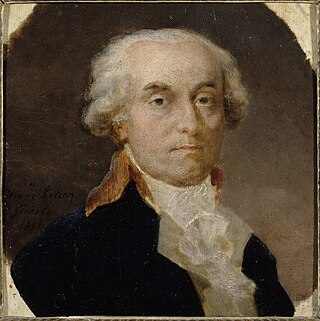
Jérôme Pétion de Villeneuve was a French writer and politician who served as the second mayor of Paris, from 1791 to 1792.

The Society of the Friends of the Rights of Man and of the Citizen, mainly known as Cordeliers Club, was a populist political club during the French Revolution from 1790 to 1794, when the Reign of Terror ended and the Thermidorian Reaction began.
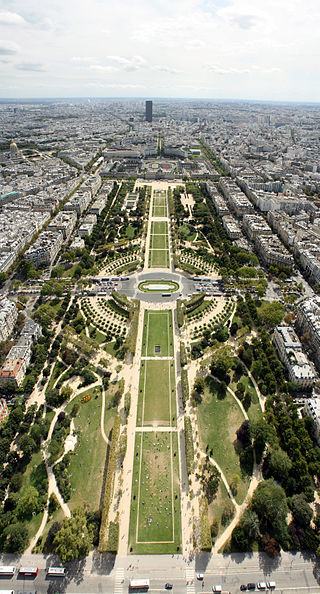
The Champ de Mars is a large public greenspace in Paris, France, located in the seventh arrondissement, between the Eiffel Tower to the northwest and the École Militaire to the southeast. The park is named after the Campus Martius in Rome, a tribute to the Roman god of war. The name alludes to the fact that the lawns here were formerly used as drilling and marching grounds by the French military.
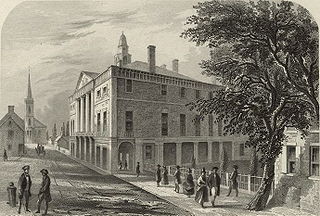
The 1st United States Congress, comprising the United States Senate and the United States House of Representatives, met from March 4, 1789, to March 4, 1791, during the first two years of George Washington's presidency, first at Federal Hall in New York City and later at Congress Hall in Philadelphia. With the initial meeting of the First Congress, the United States federal government officially began operations under the new frame of government established by the 1787 Constitution. The apportionment of seats in the House of Representatives was based on the provisions of Article I, Section 2, Clause 3 of the Constitution. Both chambers had a Pro-Administration majority. Twelve articles of amendment to the Constitution were passed by this Congress and sent to the states for ratification; the ten ratified as additions to the Constitution on December 15, 1791, are collectively known as the Bill of Rights, with an additional amendment ratified more than two centuries later to become the Twenty-seventh Amendment to the United States Constitution.

The Province of Quebec was a colony in British North America which comprised the former French colony of Canada. It was established by the Kingdom of Great Britain in 1763, following the conquest of New France by British forces during the Seven Years' War. As part of the Treaty of Paris, France gave up its claim to the colony; it instead negotiated to keep the small profitable island of Guadeloupe.
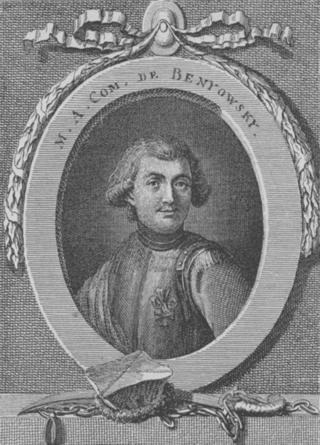
Count Maurice Benyovszky de Benyó et Urbanó was a renowned military officer, adventurer, and writer from the Kingdom of Hungary, who described himself as both a Hungarian and a Pole. He is considered a national hero in Hungary, Poland, and Slovakia.
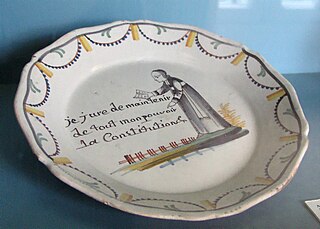
The Civil Constitution of the Clergy was a law passed on 12 July 1790 during the French Revolution, that caused the immediate subordination of most of the Catholic Church in France to the French government. As such, a schism was created, resulting in a small remnant French Catholic Church loyal to the Papacy, and a much larger "constitutional church" subject to the French state. The schism was not fully resolved until 1801.
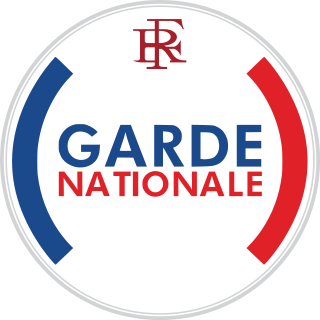
The National Guard is a French military, gendarmerie, and police reserve force, active in its current form since 2016 but originally founded in 1789 during the French Revolution.
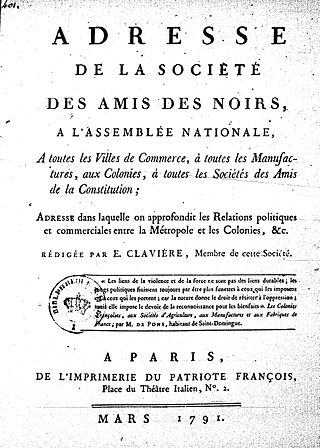
The Society of the Friends of the Blacks was a French abolitionist society founded during the late 18th century. The society's aim was to abolish both the institution of slavery in the France's overseas colonies and French involvement in the Atlantic slave trade. The society was founded in Paris in 1788, and remained active until 1793, during the midst of the French Revolution. It was led by Jacques Pierre Brissot, who frequently received advice from British abolitionist Thomas Clarkson, who led the abolitionist movement in Great Britain. At the beginning of 1789, the Society had 141 members.

Charles Thévenin was a neoclassical French painter, known for heroic scenes from the time of the French Revolution and First French Empire.

Jupiter was a Téméraire class 74-gun ship of the line of the French Navy.

Jean-Antoine-Joseph de Bry, also spelled Debry, was a French politician of the French Revolution. He served as President of the National Convention, and is famous for the slogan La patrie est en danger he proposed.

The Théâtre Feydeau, a former Parisian theatre company, was founded in 1789 with the patronage of Monsieur, Comte de Provence, and was therefore initially named the Théâtre de Monsieur. It began performing in the Salle des Tuileries, located in the north wing of the Tuileries Palace, then moved to the Salle des Variétés at the Foire Saint-Germain, and finally, beginning in 1791, settled into its own custom-built theatre, the Salle Feydeau located on the rue Feydeau. The company was renamed Feydeau after the royal family was arrested during the French Revolution.

The 1790–91 United States Senate elections were the second series of elections of senators in the United States. In these elections, terms were up for the nine senators in Class 1. As of these elections, formal organized political parties had yet to form in the United States, but two political factions were present: The coalition of senators who supported President George Washington's administration were known as the Pro-Administration Party, and the senators against him as the Anti-Administration Party.

The Society of 1789, or the Patriotic Society of 1789, was a political club of the French Revolution inaugurated during a festive banquet held at Palais-Royal in May 13, 1790 by more moderate elements of the Club Breton. At their height of influence, it was the second most important club after the Jacobin Club.
Anne Félicité Colombe, was a French printer and publisher, and a political activist during the French revolution. She published the radical journals L'Ami du Peuple and l'Orateur du Peuple.